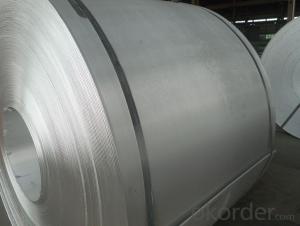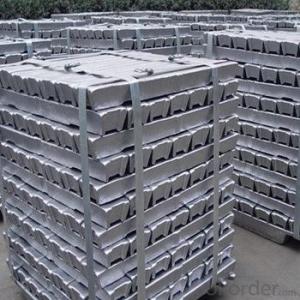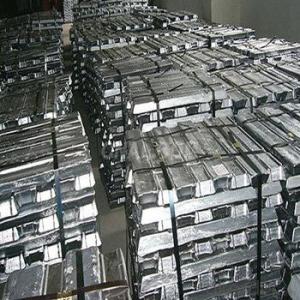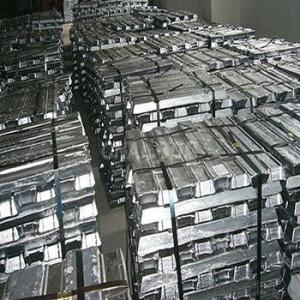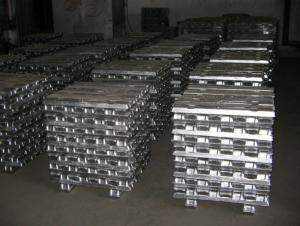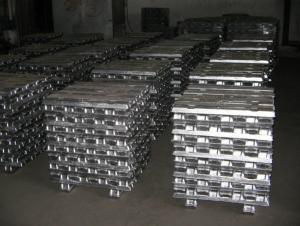Aluminum casting master coil AA1070 iqual to P1020 for melt
- Loading Port:
- Tianjin
- Payment Terms:
- TT OR LC
- Min Order Qty:
- 200 m.t.
- Supply Capability:
- 5000 m.t./month
OKorder Service Pledge
OKorder Financial Service
You Might Also Like
Aluminium alloys (or aluminum alloys; see spelling differences) are alloys in which aluminium (Al) is the predominant metal. The typical alloying elements are copper, magnesium, manganese, silicon, tin and zinc. There are two principal classifications, namely casting alloys and wrought alloys, both of which are further subdivided into the categories heat-treatable and non-heat-treatable. About 85% of aluminium is used for wrought products, for example rolled plate, foils and extrusions. Cast aluminium alloys yield cost-effective products due to the low melting point, although they generally have lower tensile strengths than wrought alloys. The most important cast aluminium alloy system is Al–Si, where the high levels of silicon (4.0–13%) contribute to give good casting characteristics. Aluminium alloys are widely used in engineering structures and components where light weight or corrosion resistance is required
Specification:
Alloy: AA1070
Temper: F
Thickness:6mm—100mm
Width: 900mm—2300mm (Can be slitted)
Inner Diameter: 508MM
Coil Weight: AS REQUIRED
Application: MELT FOR LINGOTE TO MAKE ALUMINUM COIL O PLATE
Features:
1. Excellent quality of products
2. Quick delivery
3. Best service to clients
4. BV,SGS avalible
5. No buckle o waveness
6. Tension leveling
7. Certificate of Origin
8. Form A,E,F
Packaging Detail:
Carton ,Wooden pallet with plastic protection packing ,standard seaworthy packing or as your request.
Production Capacity:
Annual Production capacity of 600,000 tons.
Products are exported to United States, Canada, U.A.E, Brazil, Mexico,Thailand, Vietnam, Nigeria etc, over 100 countries and regions all over the world.
Production Line:
CNBM aluminum production base is comprised of 18 aluminum annealers, 10 coil and foil mills, 4 continuous production lines, 2 hot rolling production line and 3 prepainted lines.
FAQ:
1. What is the form of payment?
Normally 30% TT, 100% L
/C AT SIGHT
2. Type of quotation?
FOB, CFR, CIF
3. Port of loading?
Any port in China
4. Delivery time?
30 day after client’s deposit
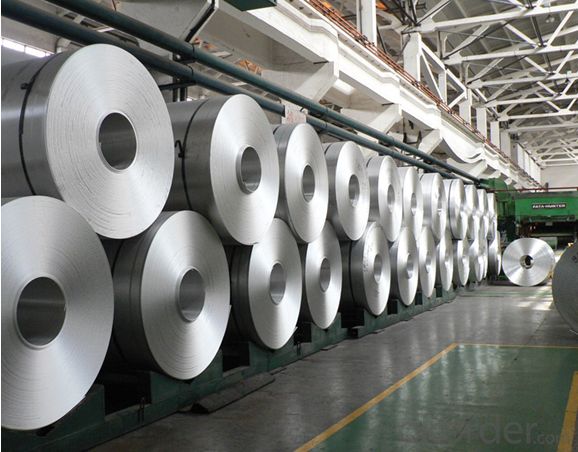
- Q:How much capital do I need to invest in the recycled aluminium ingot?
- Interests can also, but you have to look at how solid ingots sell, I mainly sell coal and carbon to the factory with multiple points of contact, but you want me to say how much the solid would ask how.
- Q:How are aluminum ingots melted?
- Aluminum ingots are typically melted using a process called smelting. Smelting is the process of extracting a metal from its ore by heating it to a high temperature, causing the metal to melt and separate from the impurities. To melt aluminum ingots, a furnace is used, which is specifically designed to withstand the high temperatures required. The ingots are loaded into the furnace and heated to temperatures ranging between 660°C to 780°C (1220°F to 1436°F). The furnace is typically fueled by natural gas, oil, or electricity. Once the ingots reach the desired temperature, they begin to melt and transform into a liquid state. At this point, any impurities or foreign materials present in the ingots separate and rise to the surface, forming a layer called dross. The dross is then removed from the surface of the molten aluminum using various techniques such as skimming or by employing specialized tools. After the dross is removed, the molten aluminum is ready for further processing or casting into various shapes. It can be poured into molds to create different products or further refined to meet specific requirements. The molten aluminum can also be alloyed with other metals to enhance its properties or mixed with additives to improve its strength, durability, or other desired characteristics. Overall, the process of melting aluminum ingots involves subjecting them to high temperatures in a furnace, allowing them to melt into a liquid state, removing any impurities, and then further processing or casting the molten aluminum as needed.
- Q:What are the different surface treatment options for aluminum ingots?
- Some of the different surface treatment options for aluminum ingots include anodizing, powder coating, painting, polishing, and sandblasting.
- Q:How are impurities removed from aluminum ingots during production?
- Impurities are eliminated from aluminum ingots in the production process through a refining process. The refining process typically consists of two primary steps: degassing and filtration. During degassing, the aluminum melt undergoes high temperatures and low pressures. This assists in the removal of volatile impurities, such as hydrogen, which can lead to porosity and brittleness in the end product. The high temperature and low pressure conditions permit the impurities to escape as gas bubbles, which are subsequently extracted from the melt. Filtration follows as the subsequent stage of impurity removal. The aluminum melt is passed through a filtration system containing ceramic filters or other porous materials. These filters are designed to trap solid impurities like oxides, non-metallic particles, and other foreign materials. The filters possess a specific pore size that exclusively allows the molten aluminum to pass through while retaining the impurities. This filtration process aids in enhancing the quality of the aluminum by reducing the levels of non-metallic inclusions, which can detrimentally impact the mechanical properties of the final product. It also contributes to regulating the grain structure and enhancing the overall homogeneity of the aluminum ingots. In conjunction with degassing and filtration, other refining techniques, such as fluxing and electromagnetic stirring, may also be implemented based on the specific requirements of the production process. Fluxing encompasses the addition of chemical compounds to the aluminum melt to facilitate impurity removal. Electromagnetic stirring employs electromagnetic fields to augment the mixing and distribution of the melt, thereby assisting in impurity elimination. Overall, impurities in aluminum ingots are effectively eliminated during production by combining degassing, filtration, fluxing, and electromagnetic stirring processes. These refining techniques guarantee that the final aluminum product adheres to the desired quality standards and exhibits optimal mechanical properties.
- Q:How are aluminum ingots used in the production of architectural structures?
- Due to their numerous advantageous properties, aluminum ingots find widespread usage in the production of architectural structures. They serve as the raw material for manufacturing various aluminum products, such as beams, columns, façades, and roofing systems. One of the primary rationales for employing aluminum ingots in architectural structures lies in their lightweight nature. Aluminum is considerably lighter than conventional construction materials like steel or concrete. This characteristic facilitates the transportation, handling, and installation of finished architectural components, thereby reducing overall construction time and costs. In addition, aluminum ingots possess exceptional corrosion resistance. When exposed to the elements, aluminum develops a natural oxide layer that shields it from rust and decay. This property ensures the longevity and visual appeal of architectural structures made from aluminum ingots, even in harsh environments. The versatility of aluminum ingots also plays a pivotal role in architectural applications. Aluminum can be readily extruded, cast, or molded into various shapes and profiles, enabling architects and designers to fashion unique and intricate structures. This flexibility allows for the production of custom-made components that fulfill specific design requirements, thereby enhancing the aesthetic appeal of the structures. Furthermore, aluminum ingots offer excellent thermal and electrical conductivity. This feature proves particularly advantageous in architectural structures as it facilitates efficient energy transfer and distribution. Aluminum components can be seamlessly integrated into heating, ventilation, and air conditioning systems, ensuring optimal energy efficiency and cost savings. Moreover, aluminum ingots demonstrate high sustainability and environmental friendliness. Aluminum is 100% recyclable without compromising its original properties, making it the preferred choice for eco-conscious architects and builders. By incorporating aluminum ingots into architectural structures, the construction industry can significantly reduce its carbon footprint and contribute to a more sustainable future. In conclusion, the many benefits of aluminum ingots, including their lightweight nature, corrosion resistance, versatility, thermal and electrical conductivity, and sustainability, make them highly suitable for the production of durable, visually appealing, and energy-efficient architectural structures that meet the demanding requirements of modern architecture.
- Q:How do aluminum ingots compare to other metals in terms of strength?
- Compared to other metals, aluminum ingots possess distinct strength characteristics. Generally, aluminum is not as robust as metals like steel or titanium. Nevertheless, it does display a commendable strength-to-weight ratio, rendering it suitable for a vast array of applications. The strength of aluminum ingots varies based on the alloy employed and the manufacturing process. Heat treatment can enhance the strength of aluminum alloys, but even in their natural state, they demonstrate satisfactory strength properties. Additionally, aluminum ingots exhibit exceptional corrosion resistance, making them highly coveted in industries such as aerospace, automotive, construction, and packaging. Consequently, while aluminum may not match the strength level of certain metals, its unique combination of properties still grants it significant value in various industries.
- Q:How are aluminum ingots used in the production of architectural facades?
- Aluminum ingots play a crucial role in the production of architectural facades. These ingots are the primary raw material used to manufacture various aluminum products, including facades. To begin with, the ingots are melted and then cast into different shapes and forms, such as sheets or extrusions, depending on the design requirements of the facade. This casting process allows for customization and flexibility in creating architectural elements with different sizes, profiles, and finishes. Once the aluminum is transformed into its desired form, it undergoes further processing, such as cutting, bending, and machining, to achieve the specific design details required for the facade. This flexibility allows architects and designers to create intricate patterns, shapes, and textures, enhancing the overall aesthetic appeal of the building's exterior. Additionally, aluminum ingots possess excellent strength-to-weight ratio and corrosion resistance properties. These characteristics make aluminum an ideal choice for architectural facades as it can withstand harsh weather conditions, including heavy rain, strong winds, and extreme temperatures, without compromising its structural integrity. Moreover, aluminum facades are known for their durability and low maintenance requirements. The corrosion resistance of aluminum ensures that the facade can retain its original appearance for an extended period, reducing the need for frequent repairs or replacements. Furthermore, aluminum is a sustainable material as it can be recycled repeatedly without losing its quality. This recyclability aspect makes it an environmentally-friendly choice for architectural facades, aligning with the increasing focus on sustainable construction practices. In conclusion, aluminum ingots are essential in the production of architectural facades due to their versatility, strength, durability, and sustainability. The ability to mold aluminum into various shapes and forms allows for the creation of visually appealing and functional facades that withstand the test of time and contribute to sustainable building practices.
- Q:How do aluminum ingots contribute to the overall aluminum industry?
- Aluminum ingots play a crucial role in the overall aluminum industry as they serve as the primary raw material for the production of various aluminum products. These ingots are melted down and cast into different shapes, allowing manufacturers to create a wide range of aluminum-based products used in various industries, such as construction, automotive, aerospace, packaging, and electronics. Thus, aluminum ingots are vital for sustaining the growth and development of the aluminum industry by providing the necessary material for the manufacturing of diverse aluminum products.
- Q:What kind of aluminum consumption does the furnace compare with natural gas?
- The aluminum loss of the reverberatory furnace is proportional to the melting time: the longer the loss is, the higher the temperature of the flame, the aluminum surface continues to oxidize to alumina powder.
- Q:What elements do alloy die casting ingots require?
- Silicon is the major element in most die cast aluminum alloys. It can improve the casting properties of alloys. Silicon and aluminum can form solid solutions. At 577 DEG C, the solubility of silicon in aluminium is 1.65%, at room temperature is 0.2%, and when silicon content is up to 11.7%, silicon and aluminum form eutectic. Improve the high temperature molding properties of the alloy, reduce shrinkage, no hot cracking tendency. Two element aluminum base alloy has high corrosion resistance. When the content of silicon in the alloy exceeds the eutectic component, and the impurities such as copper and iron are long, the hard point of free silicon appears, which makes the machining difficult. The corrosion of the cast silicon crucible by high silicon aluminum alloy is serious.
1. Manufacturer Overview |
|
|---|---|
| Location | |
| Year Established | |
| Annual Output Value | |
| Main Markets | |
| Company Certifications | |
2. Manufacturer Certificates |
|
|---|---|
| a) Certification Name | |
| Range | |
| Reference | |
| Validity Period | |
3. Manufacturer Capability |
|
|---|---|
| a)Trade Capacity | |
| Nearest Port | |
| Export Percentage | |
| No.of Employees in Trade Department | |
| Language Spoken: | |
| b)Factory Information | |
| Factory Size: | |
| No. of Production Lines | |
| Contract Manufacturing | |
| Product Price Range | |
Send your message to us
Aluminum casting master coil AA1070 iqual to P1020 for melt
- Loading Port:
- Tianjin
- Payment Terms:
- TT OR LC
- Min Order Qty:
- 200 m.t.
- Supply Capability:
- 5000 m.t./month
OKorder Service Pledge
OKorder Financial Service
Similar products
New products
Hot products
Related keywords
